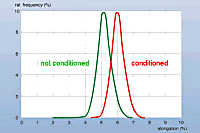YARN CONDITIONING
Why conditioning is required?
Moisture in atmosphere has a great impact on the physical properties of textile fibres and yarns.Relative humidity and temperature will decide the amount of moisure in the atmosphere. High relative humidity in different departments of spinning is not desirable. It will result in major problems. But on the otherhand, a high degree of moisture improves the physical properties of yarn. Moreover it helps the yarn to attain the standard moisture regain value of the fibre. Yarns sold with lower moisture content than the standard value will result in monetary loss. Therefore the aim of CONDITIONING is to provide an economical device for supplying the necessary moisture in a short time, in order to achieve a lasting improvement in quality.
In these days there is a dramatic change in the production level of weaving and knitting machines, because of the sophisticated manufacturing techniques. Yarn quality required to run on these machines is extremely high. In order to satisfy these demands without altering the rawmaterial, it was decided to make use of the physical properties inherent in the cotton fibres. Cotton fibre is hygroscopic material and has the ability to absorb water in the form of steam. It is quite evident that the hygroscopic property of cotton fibres depends on the relative humidity. The higher the humidity, more the moisture abosrption. The increase in the relative atmospheric humidity causes a rise in the moisture content of the cotton fibre, following an S-shaped curve.
The relative humidity in turn affects the properties of the fibre via the moisture content of the cotton fibre.
CONTEXXOR CONDITIONING PROCESS BY XORELLA:
The standard conventional steaming treatment for yarn is chiefly used for twist setting to avoid snarling in further processing. It does not result in lasting improvement in yarn quality. The steaming process may fail to ensure even distribution of the moisture, especially on cross-wound bobbins(cheeses) with medium to high compactness. The thermal conditioning process of the yarn according to the CONTEXXOR process developed by XORELLA is a new type of system for supplying the yarn package.
The absence of Vacuum in conventional conditioning chambers, prevents homogeneous penetration. The outer layers of the package are also too moist and the transition from moist to dry yarn gives rise to substantial variations in downstream processing of the package, both with regard to friction data and strength.
Since the moisture is applied superficially in the wet steam zone or by misting with water jets, it has a tendency to become re-adjusted immediately to the ambient humidity level owing to the large surface area. Equipment of this king also prevents the optimum flow of goods and takes up too much space.
PRINCIPLE OF WORKING:
Thermal conditioning uses low-temperature saturated steam in vacuum. With the vacuum principle and indirect steam, the yarn is treated very gently in an absolutely saturated steam atmosphere. The vacuum first removes the air pockets from the yarn package to ensure accelerated steam penetration and also removes the atmospheric oxygen in order to prevent oxidation. The conditioning process makes use of the physical properties of saturated steam or wet steam (100% moisture in gas-state). The yarn is uniformly moistened by the gas. The great advantage of this process is that the moisture in the form of gas is very finely distributed throughout the yarn package and does not cling to the yarn in the form of drops.

pic: XORELLA CONDITIONING SYSTEM
- ADVANTAGES OF CONTEXXOR PROCESS:
- saturated steam throughout the process
- even penetration of steam and distribution of moister
- lowest energy consumption with XORELLA ECO-SYSTEM
- short process time
- absolute saturated steam atmosphere of 50 degree C to 150 degreees C.
- no additional boiler required, the steam is generated in the system
- minimum energy consumption(approx. 25 KWh for 1000 kgs of yarn)No tube buckling in case of mad-made yarns
- treatment of all natural yarns, blends, synthetics and microfibre yarns.
- low installation and maintenance cost
- preheating for trollys and plastic tubes to avoid drops (Wool)
- standardize sizes
- length up to 20 meters (66 feet) and max. temperature deviation of 1°C
- various loading and unloading facilities
- no contamination of the treated packages
- energy recovery option offered by indirect heating system using steam or hot water
- no special location required, the systems can be operated next to the production machines.
BENEFITS ACHIEVED OUT OF CONDITIONING:
FOR KNITTING:
The treatment temperature for knitting yarn is held below the melting point of the wax. Temperatures for unwaxed
yarn are coordinated to the compatibility fo each individual type of yarn
- Upto 20% greater efficiency due to a reduction in the unwinding tension
- fewer needle breaks
- uniform moisture content and friction values
- regular stitch formation
- no change in size of finished articles
- no extra dampening required
- free from electrostatic
- less fly hence less problems. It helps if the yarn is running on a closer gauge machines
NOTE: Please note that the wax applied should be able to withstand min 60 degree centigrade. If low quality wax is used, it will result in major problem. Conditioning should be done at 55 to 60 degree centigrade.
FOR WEAVING:
- upto 15% fewer yarn breaks due to greater elongation
- less fly, resulting in a better weaving quality
- increased strength
- increased take-up of size, enhanced level of efficiency in the weaving plant
- softer fabrics


Pic: improved strength Pic: improved elongation
FOR TWISTING:
Conditioning and fixing of the twist at the same time in a single process.
FOR DYEING:
- no streaks
- better dye affinity

Pic: dye pick up of conditioned and unconditoned yarn